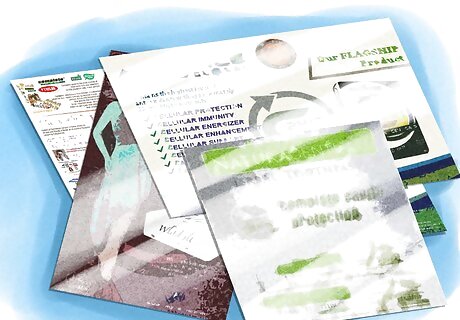
views
Organizing Your Finances

Anticipate costs. A snow plow business has a lot of upfront expenses that you must consider before going into business. Make sure you make a budget and anticipate all of the costs. Snow removal equipment -- Snow removal equipment can be very expensive, depending on what you intend to purchase. Experts suggest that a snow plow, snow blower, salt, and salt sprayer can cost anywhere between $3,000-$10,000 USD. (This does not include the price of a salt truck or other transportation). Transportation -- Unless you choose to go door to door offering your services, you will need reliable transportation and gas for your business. Consider the cost of winter maintenance on your vehicle as well as common expenses such as fuel. Insurance -- Some business require their owners to carry insurance for liability purposes. You may also decide to take an insurance policy on your equipment. Further, some states require insurance on operating vehicles. Personal weather gear -- You will have to dress for the job. This may be a solid and sturdy pair of boots, gloves, and coat. You will want to have warm weather gear to protect yourself on the job.

Research how much you will charge. To determine benefit vs. risk, you should research similar businesses in your area. You want to do this to not only determine how much money you can realistically expect to make, but also to set competitive prices. Do an internet search for local snow removal companies. Check their websites or call and request a quote. Realize that different parts of the country, or different times of the year, may reflect in prices. Price may depend on clients; if you are planning on removing snow from commercial properties, the price may be different than private residents.

Apply for a loan, if you need to. If you are serious about making this your professional career, you can take out a loan with your local bank to help fund your startup. Prepare a solid business plan including budget, vision, and competitive analysis. Prepare personal financial documents including credit report, annual earnings, and tax history. Talk to a bank loan representative and be precise in what you want. Explain how much money you intend to take out and how you will spend it. Try and be as precise as possible when discussing how you will spend the bank’s money. Be sure you can meet the loan’s requirements and be able to make payments, including interest, back to the bank.

Weigh the benefits vs the costs. Ask yourself if the benefits of your business will outweigh the costs you expect to pay. Consider: Will I make enough money to pay back a loan if I take one out? Will the work be worth the time and effort I put into this? How much money can I expect to realistically make? You can determine this by looking at other companies in your area to see how much they charge. Keep in mind, companies will charge both by single job and by seasonal contract. Will it snow enough (now and in the future) to make this business worth it?
Registering Your Business

Choose an appropriate business type. There are a few types of business structures you can decide between when registering a business.Here are three common ones: Sole Proprietorship -- You are the only operator of your company and are personally liable for its assets and liabilities. Limited Liability Company (LLC) -- This provides limited liability to the business owner. It offers some tax benefits and exemptions for those involved. Corporation -- This is a more established, and larger, business. This structure generally has taxable employees. Note that your business type, at least in the US, is not permanent. If you want to change from an LLC to a corporation you are able to do so.

Pick an appropriate name. Your business’s name will be the framework for your work. It will be the first thing that identifies you and the work that you do. This important step in the business process should be considered with the following in mind: How will your name appear on advertisements and/or promotional material? Does my name clearly identify what I am trying to advertise? Is it unique? Are there any negative connotations that may be associated with this name? Is the name memorable and will it catch the attention of potential clients?

Check for trademarks. Before you register your name, make sure that it is not trademark protected. This means that your name is too similar to a name that is already registered and protected by the government. Infringing on trademark or copyright material can be a costly mistake! If you intend to register in the United States, you can search names through the U.S. Patent and Trademark office. If you intend to register in Canada, you can search names through the Intellectual Property Office.

Register your business nationally. Once you have picked an appropriate name for your snow plow business, now you must register it with your government. This is for tax and legal purposes. Determine if you need to file a “Doing Business As” (DBA)Name. You will have to register and complete this paperwork if you business’s name is different than your own legal name. You may also be required to register if you are operating anything other than a LLC or sole proprietorship. File your business structure. This application will allow the government to check if your business name is legal and unique. This will also register your name so no one else can use it. Trademark your name if you want full protection. You must do this through your government’s business agency. In the United States, this is the only way to protect your business name in all states.

Register your business in your state. If you are in the US, you will need to register your company based on your state’s laws. Each state may have their own unique requirements, so be sure to research on your state or government website. Your city or village hall may also have information available about state requirements. The Secretary Of State may provide statewide information on the state’s website.

Obtain a business license and/or permit. Again, what license or permit you may need to acquire may be unique to your state or country. Be sure to check with your local government to avoid breaking laws. In Milwaukee, Minnesota, for example, you need a unique “Snow Plow Business” license, provided by the City Clerk’s Office.
Marketing Your Business

Identify your market. Consider where would you like to work and what sort of driveway are you looking to plow or shovel. Consider: Your local neighborhood - is there someone already plowing or shoveling your neighborhood’s driveways? If not, this might be a great, and local, place to start. Retirement communities - the elderly or infirm may need someone to plow their driveways. This might be a good market. Local businesses -- Talk with local business owners to see if they need someone to come in and plow the parking lots.

Determine how many clients you will want to take on. There are many things to consider when constructing a client base. You should be aware of how much work you can realistically do without over-extending yourself. This may depend on a number of things: Personal time availability - how many hours a week do you expect to work? Equipment quality -- will your equipment be sufficient for the hours you are working? Staff -- do you have enough competent and trustworthy staff to take on the required work?

Get online. A great place to advertise is online. You can set up an advertisement using search engine optimization (SEO) or even place an advertisement on popular social media websites.

Market by word-of-mouth. If you plan on keeping your business local, consider advertising by word-of-mouth. Talk to your neighbors and friends and ask if they can get the word out. You can even go door to door advertising your services. Make and distribute professional business cards advertising your services.

Consider flyers, signs, or newspaper advertisements. This advertisement strategy may catch the eye of local residents. Make sure your information is clear, concise, and legible. Make your font easy to read and provide your contact information.


















Comments
0 comment